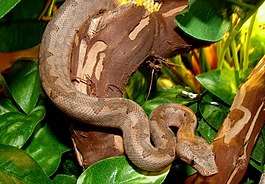Candoia
Candoia is a genus of non-venomous boas found mostly in New Guinea and Melanesia. Five species are recognized as being valid.[2] Common names include: bevel-nosed boas, keel-scaled boas.[2]
| Candoia | |
|---|---|
 | |
| Candoia carinata, Pacific boa | |
| Scientific classification | |
| Kingdom: | Animalia |
| Phylum: | Chordata |
| Class: | Reptilia |
| Order: | Squamata |
| Suborder: | Serpentes |
| Family: | Boidae |
| Subfamily: | Candoiinae |
| Genus: | Candoia Gray, 1842 |
| Synonyms[1] | |
Description
Member species of the genus Candoia typically have a rounded and heavy body, with a flattened triangular-shaped head, and an upturned nose. Colors and patterns vary greatly, but most are various shades of brown to black. Species can vary in adult size from 60 cm (24 in) to 1.8 m (5.9 ft) in total length (including tail). Males are typically smaller than females and can be distinguished by their prominent cloacal spurs.
Distribution and habitat
Species of the genus Candoia are found from Samoa and Tokelau west through Melanesia to New Guinea and the Maluku Islands.[1]
Behavior
All species of Candoia are primarily nocturnal.
Feeding
The primary diet of Candoia species consists of frogs and lizards.
Reproduction
In the genus Candoia breeding occurs early in the year, typically after rains. Several males will approach and pursue a single female, though, there is no combat between the males. Females seem to only ovulate once every two or three years and give birth to litters averaging 10 or so neonates. The Solomon Island ground boa, C. paulsoni, is an exception as it is known to have particularly large litters, occasionally producing 30 or 40 small neonates.
Captivity
Snakes of the genus Candoia are frequently imported for the exotic pet trade, but are now being bred in captivity with some regularity by private individuals. Their small size and ease of care make them interesting captives, but wild caught specimens are not known to acclimate well. The stress of captivity manifests itself in the form of lack of interest in food. Their natural diet often presents a problem for hobbyists mainly familiar with using rodents as food.
Species
| Species[2] | Taxon author[2] | Subsp.*[2] | Common name[3] | Geographic range[1] |
|---|---|---|---|---|
| C. aspera | (Günther, 1877) | 0 | New Guinean boa | New Guinea (Irian Jaya and Papua New Guinea below 1300 m), including the nearby islands of Waigeu, Batanta, Misool and Salawati, the islands of Biak and Japen in Geelvink Bay, Seleo, Valise, Karkar, Umboi, Manus, Los Negros, Lou, Baluan, the Rambatyo Islands in the Manus Group (Admiralty Islands), New Britain, Duke of York, New Ireland and New Hanover in the Bismarck Archipelago. |
| C. bibroni | (A.M.C. Duméril & Bibron, 1844) | 1 | Fiji boa | Melanesia and Polynesia, including the eastern Solomon Islands (Olu Malau, Reef, Rennell, San Critobal, Santa Ana, Santa Cruz, Bio, Bellona, Three Sisters, Ugi and Vanikoro), the Banks Islands (Vanua Lava Island), the New Hebrides, all three of the Loyalty Islands, the Fiji Islands (Rotuma, the Yasawa Group and the Lau Group), Western Samoa (Savii and Upolu islands) and American Samoa (Ta'u Island). |
| C. carinataT | (Schneider, 1801) | 1 | Pacific boa | Indonesia, including the northern peninsula of Sulawesi, Sangihe and Telaud Islands, the northern Maluku Islands (Ceram, Ambon, Haruku, Saparua, Banda, Goram and Tanimbar), Misool, Batanta, Salawatti, Anaguar (Saipan) and the Palau Group (at least on Koror Island). New Guinea: the islands of Geelvink Bay and those along the north coast, including Liki, Djamna, Karkar and the Umboi islands. Manus and nearby islands. The Bismarck Archipelago, including the islands of Mussau and Tench. The islands of Milne Bay Province, at least on Samarai, Kiriwina, Kitava, Goodenough, Fergusson, Dobu, Normanby, Slade, Misima, Woodlark, Sudest and Rossel. The islands of Buka, Bougainville and those nearby. The Solomon Islands, including Santa Cruz, Rennell and Bellona. |
| C. paulsoni | (Stull, 1956) | 5 | Solomon Island ground boa | Indonesia. |
| C. superciliosa | (Günther, 1863) | 0 | Palau bevel-nosed boa[2] | Palau.[4] |
*) Not including the nominate subspecies.
T') Type species.
Classification
The genus Candoia is traditionally placed in the subfamily Boinae. However, a 2013 study comparing DNA sequences of 12 genes of over 4000 species supported Candoia as more distantly related, with remaining members of the Boinae being more closely related to the boid subfamily Erycinae; thus Candoia was placed in the newly named subfamily Candoiinae.[5]
References
- McDiarmid RW, Campbell JA, Touré TA (1999). Snake Species of the World: A Taxonomic and Geographic Reference, Volume 1. Washington, District of Columbia: Herpetologists' League. 511 pp. ISBN 1-893777-00-6 (series). ISBN 1-893777-01-4 (volume).
- "Candoia". Integrated Taxonomic Information System. Retrieved 5 July 2008.
- Mehrtens JM (1987). Living Snakes of the World in Color. New York: Sterling Publishers. 480 pp. ISBN 0-8069-6460-X.
- Candoia at the Reptarium.cz Reptile Database. Accessed 5 July 2008.
- Pyron, R; Burbrink, Frank T; Wiens, John J (2013). "A phylogeny and revised classification of Squamata, including 4161 species of lizards and snakes". BMC Evolutionary Biology. 13 (1): 93. doi:10.1186/1471-2148-13-93. PMC 3682911. PMID 23627680.
External links
| Wikimedia Commons has media related to Candoia. |
- "The Candoia Page" at Kingsnake.com. Accessed 5 July 2008.
Further reading
- Gray JE (1842). "Synopsis of the species of prehensile-tailed Snakes, or Family BOIDÆ". Zoological Miscellany 2: 41-46. (Candoia, new genus, p. 43).
- Smith HM, Chiszar D, Tepedelen K, van Breukelen F (2001). "A revision of the bevel-nosed boas (Candoia carinata complex) (Reptilia: Serpentes)". Hamadryad 26 (2): 283-315.